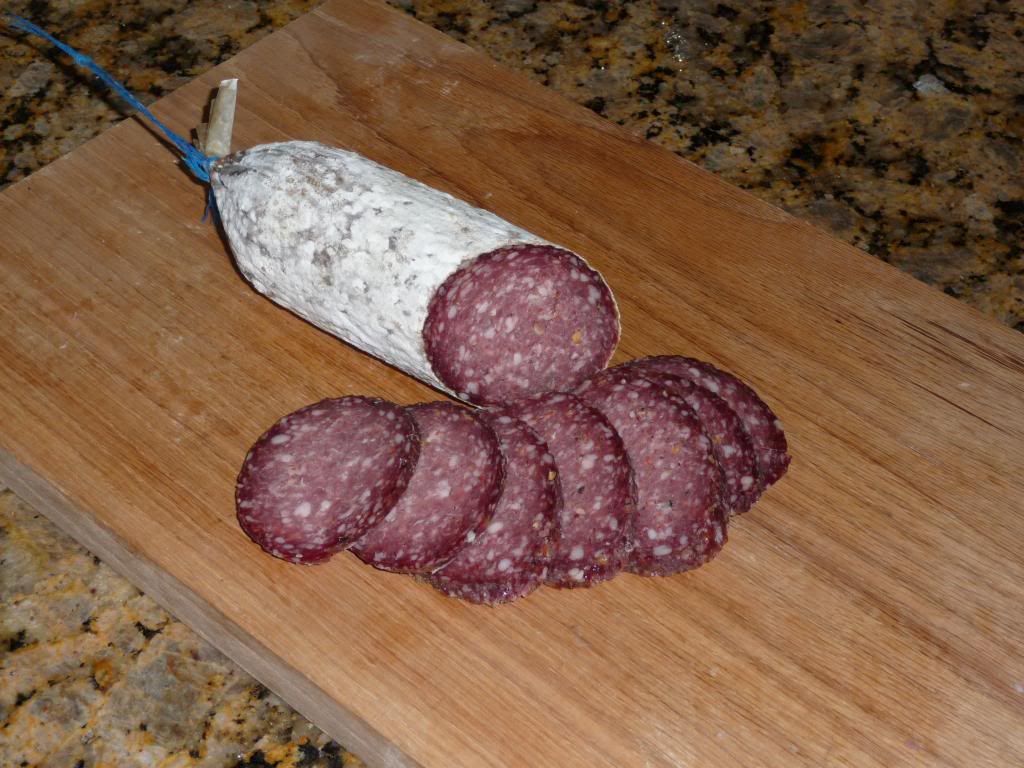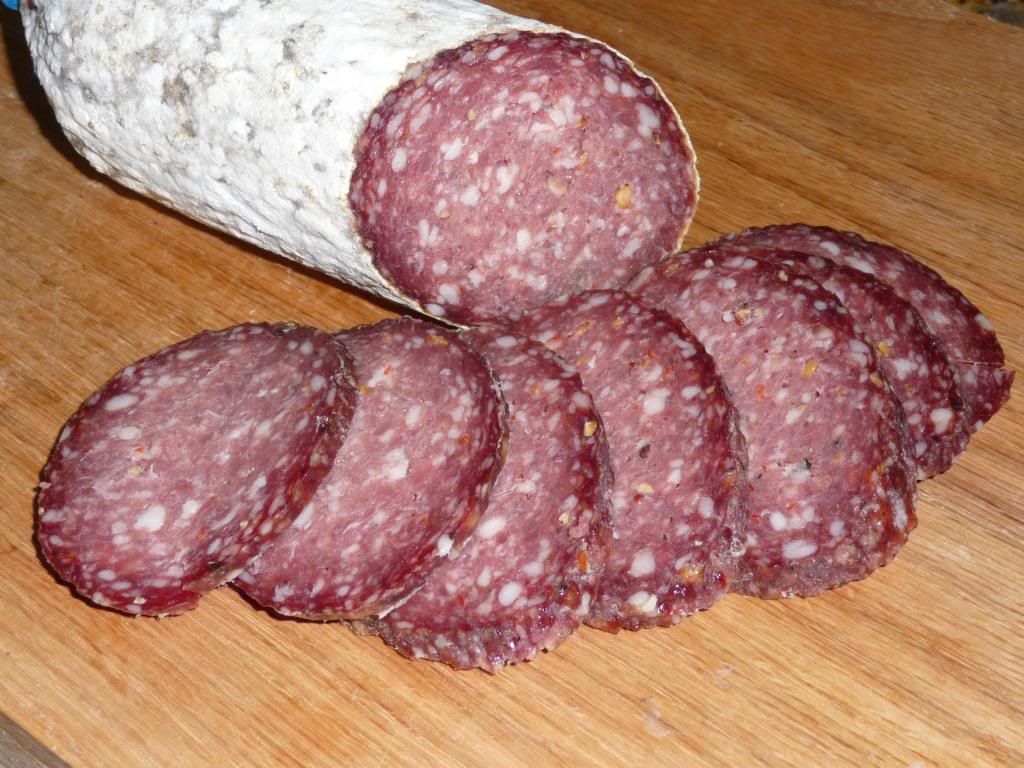Page 1 of 1
Spicy Duck Salami
Posted: Thu Apr 10, 2014 03:52
by redzed
This is a salami that was successfully fermented using probiotic cultures from yogourt. I think it will also work well with a fast acting cultures like LHP or F-RM-52. Did not turn out perfectly as there is some case hardening which I can't understand because I had three other varieties of salami in the chamber and none had a dry rim like this one. One possible explanation is that I used an artificial casing with this batch, while all the others were in beef middles. Nevertheless, I think it's still worth presenting it here since the flavour is very good and proved to be a popular appy at a recent geezer gathering. It has a distinct tang, but goes well with the heat from the red pepper flakes.


 Recipe for 1 kg
Recipe for 1 kg
400g class 1 pork
400g class 1 wild duck breasts
200g hard back fat
25g salt
2.5g Cure 2
.4g sodium erythorbate
3g dextrose
3g corn syrup solids
15g buttermilk powder
3g coarsely ground black pepper
4g (1 tablespoon) crushed red pepper flakes
1.5 tablespoon probiotic yogourt
Cube meat into 5cm chunks, mix with Cure 2 or Cure 1 and salt and leave in fridge for 48 hours. Cut fat into 2cm cubes and cure with salt only for 48 hours. Grind the meat while very cold with 10mm plate. Add the cubed fat, preferably frozen, into the ground meat and run everything through a 4.5 or 6mm plate. Mix in the seasonings and the yogourt. Mix well but take care not to over mix to avoid fat smearing. Stuff into your favourite casing. Ferment at 80F until pH drops to 5.
Posted: Thu Apr 10, 2014 11:50
by Janlab
To say it looks delicious is a gross understatement! Yummm
Jan L
Posted: Mon May 12, 2014 21:59
by rgauthier20420
This looks great! Can you let me know what the amount and brand of yogurt you used? I'm actually planning my first salami and will be using this as a starter culture.
Thanks!
Posted: Tue May 13, 2014 00:56
by ssorllih
WHAT HAVE YOU DONE TO EL DUCKO??

Posted: Tue May 13, 2014 01:36
by Gulyás
We used to say, that everything is good, if the end is good.

And I'm saying, that everything looks very good here.

Posted: Tue May 13, 2014 15:32
by redzed
rgauthier20420 wrote:This looks great! Can you let me know what the amount and brand of yogurt you used? I'm actually planning my first salami and will be using this as a starter culture.
Thanks!
Please read this thread.
http://wedlinydomowe.pl/en/viewtopic.php?t=6588
Select your yogourt carefully, make sure it is fresh and contains bacteria capable of fermenting the meat.
Posted: Tue May 13, 2014 15:35
by rgauthier20420
redzed wrote:rgauthier20420 wrote:This looks great! Can you let me know what the amount and brand of yogurt you used? I'm actually planning my first salami and will be using this as a starter culture.
Thanks!
Please read this thread.
http://wedlinydomowe.pl/en/viewtopic.php?t=6588
Select your yogourt carefully, make sure it is fresh and contains bacteria capable of fermenting the meat.
I've definitely read that thread a few times. I'm using a yogurt that says it contains L. Acidophullis (SP?) and other lives cultures. I can post a picture of the label when I get back home to confirm that this will do the job. Thanks.
Posted: Wed May 14, 2014 12:46
by redzed
Acidophilus is not a bacteria that can survive the salt and nitrites.
Posted: Wed May 14, 2014 14:34
by rgauthier20420
There are additional cultures in the yogurt, however that's the only one specifically mentioned. I'm reading another option would be a probiotic supplement. This one I'm eyeing contains Lactobacillus acidophilus, Lactobacillus GG, Lactobacillus bulgaricus, Lactobacillus casei Shirota, Bifidobacterium longum, Saccharomyces boulardii, Lactobacillus rhamnosus, and Lactobacillus reuter.
I notice a number of these are contained in the probiotic that was used in the experiment in the link you referenced previously. Also, a couple of these are listed as being in the yogurt that was used in the experiment also. Both products turned out.
Please let me know. I'm looking at stuffing the links on Thursday, and I can pick this stuff up today as it's readily available.
Thanks!
Posted: Wed May 14, 2014 14:46
by redzed
Casei, rhamnosus and bifidobacterium have a good chance of working. Ferment between 25 and 30° and humidity over 90. Use smaller gauge casings to shorten the drying period.
Good luck
Posted: Wed May 14, 2014 14:48
by rgauthier20420
redzed wrote:Casei, rhamnosus and bifidobacterium have a good chance of working. Ferment between 25 and 30° and humidity over 90. Use smaller gauge casings to shorten the drying period.
Good luck
Excellent news! Thanks a lot. I have a temp controlled chamber (from my homebrewing) and am able to maintain a RH of 87% or so. I will definitely report back with results. Thanks.




